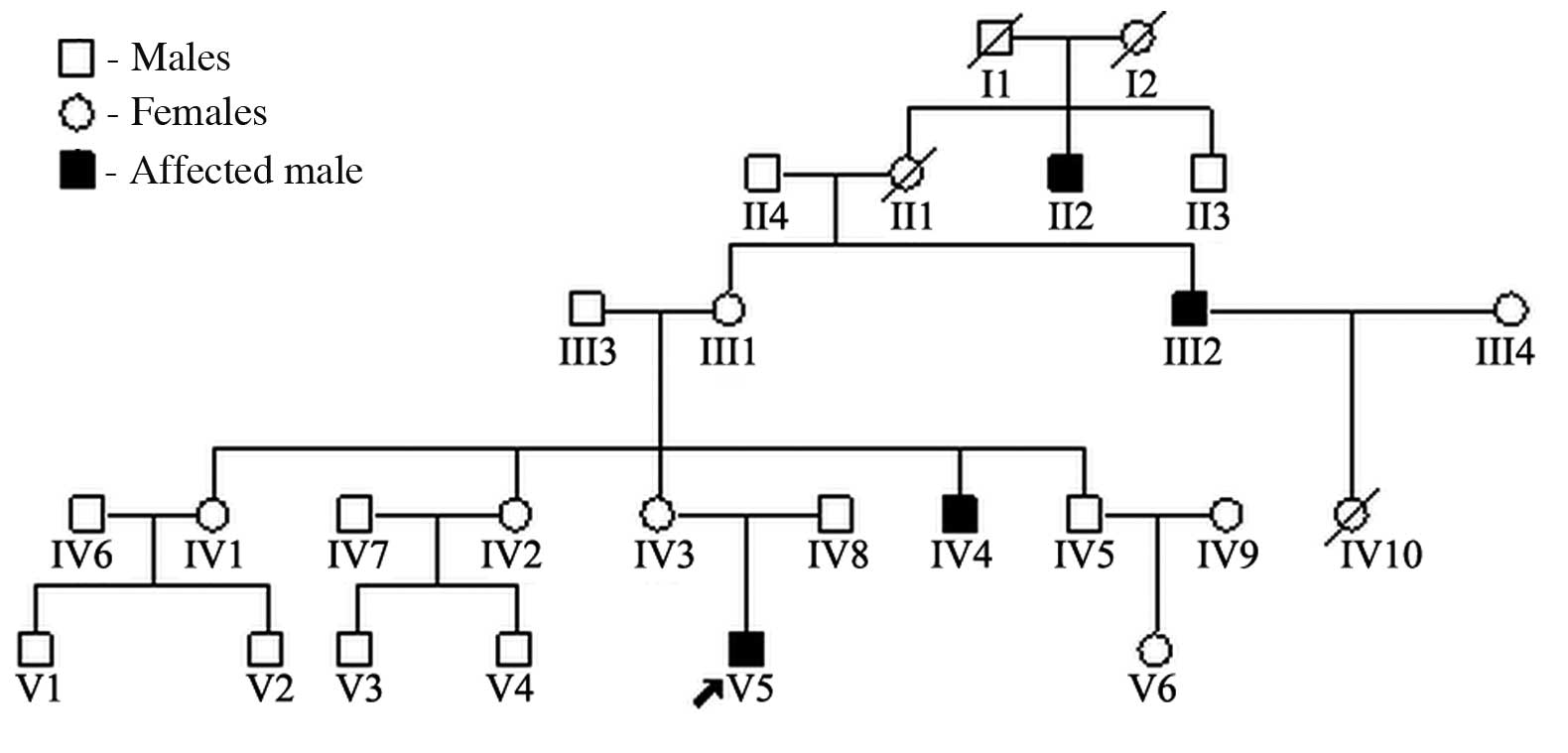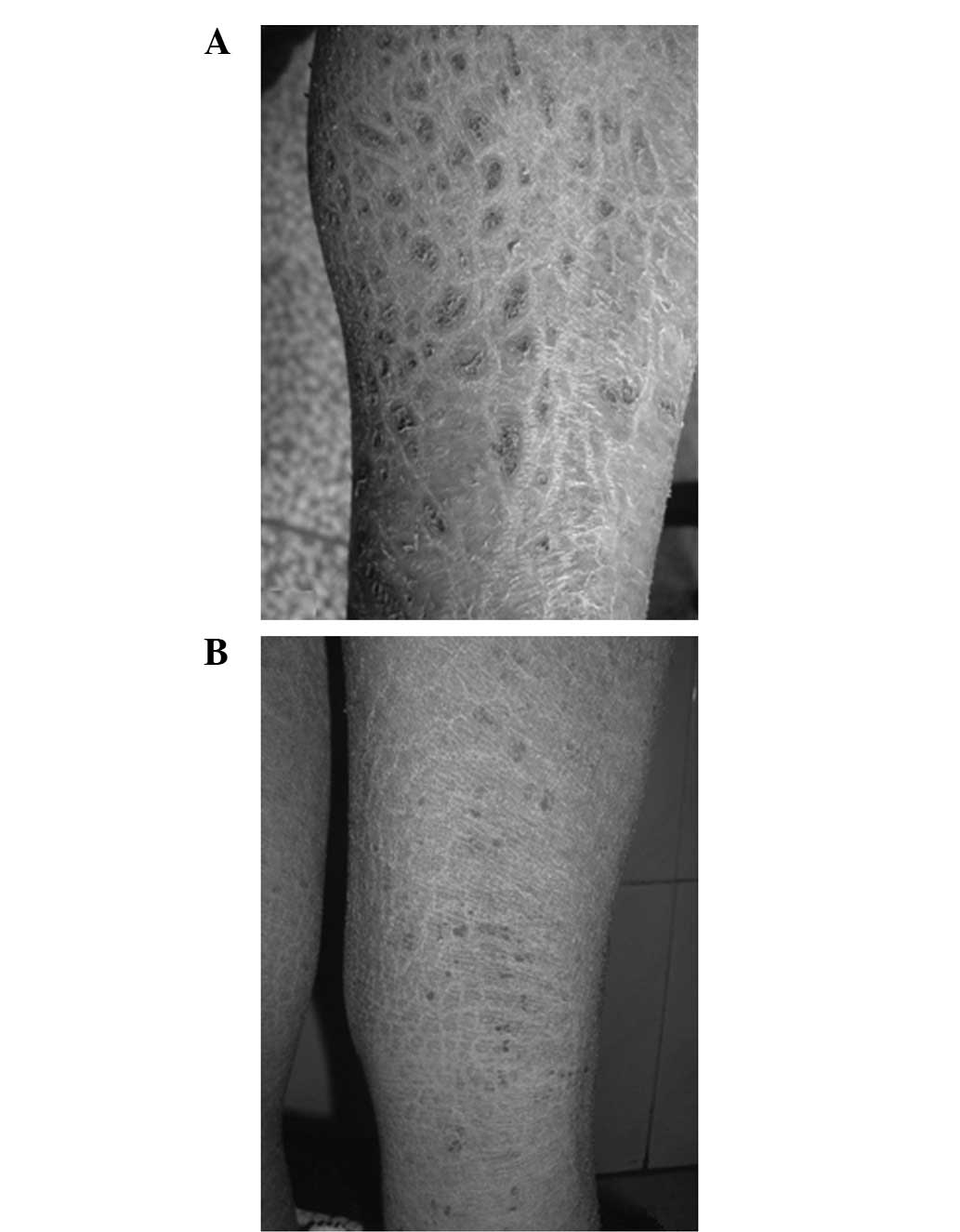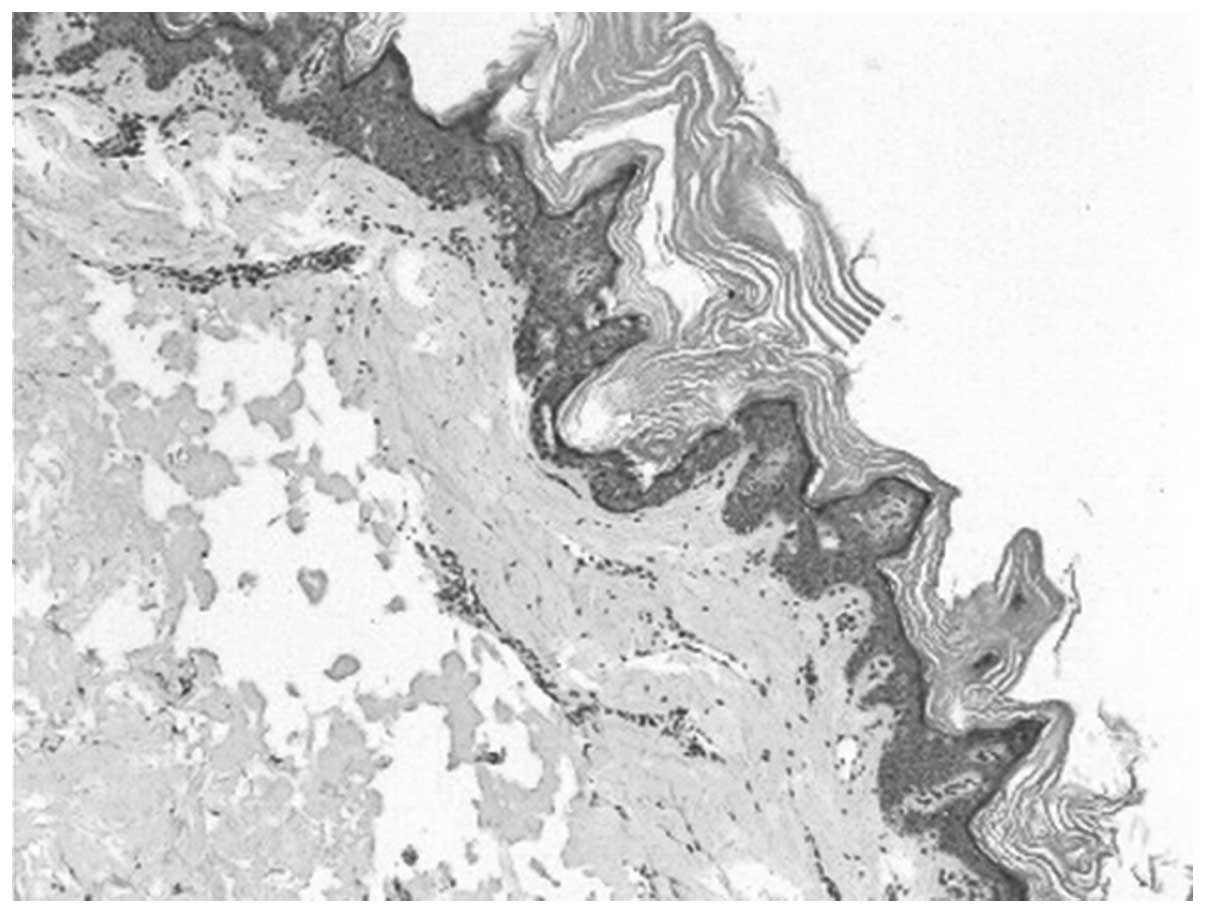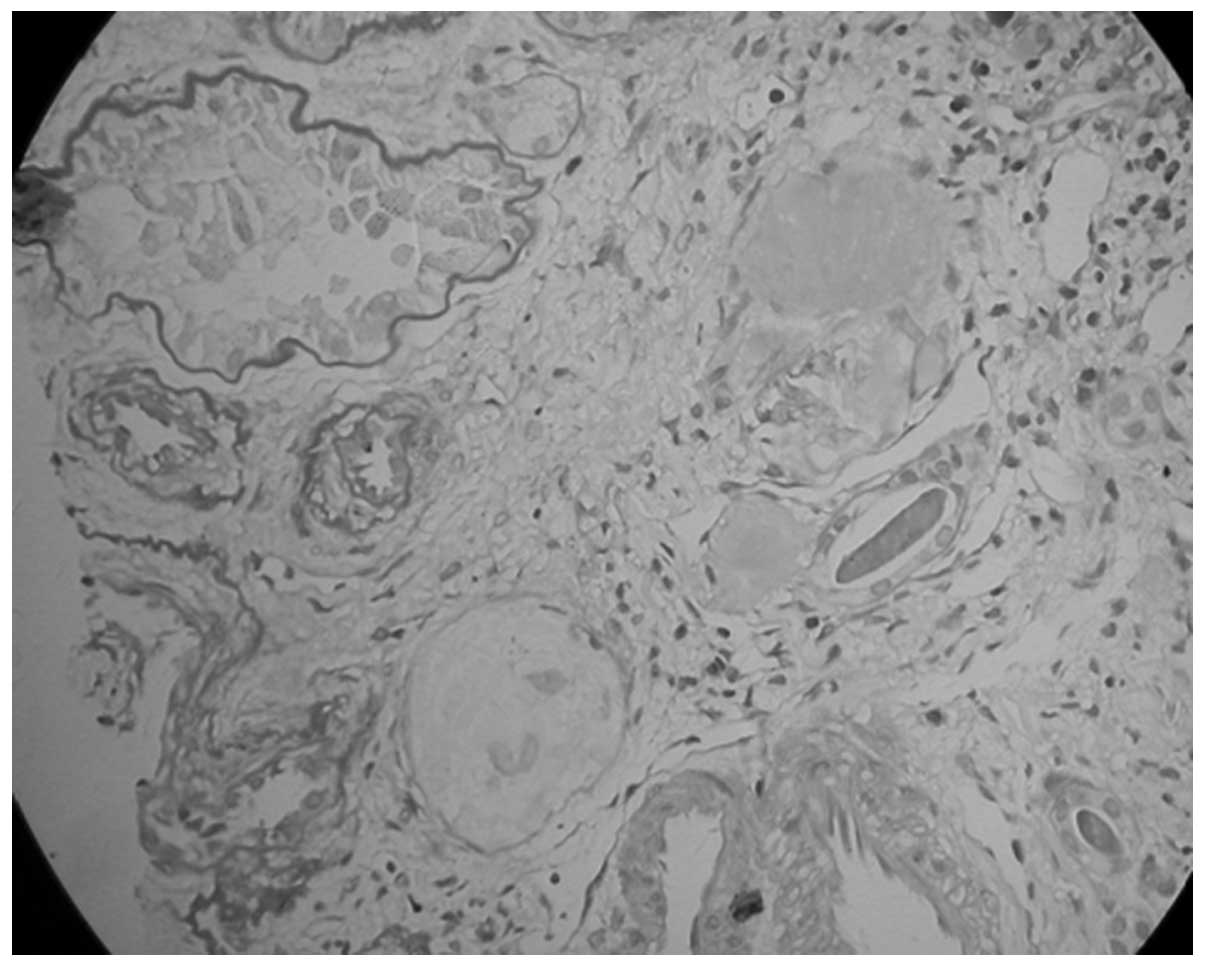Genetic analysis of a 12-year-old boy with X-linked ichthyosis in association with sclerosing glomerulonephritis
- Authors:
- Published online on: August 12, 2013 https://doi.org/10.3892/mmr.2013.1625
- Pages: 1183-1187
Abstract
Introduction
X-linked ichthyosis (XLI; OMIM #308100) is an inherited metabolic disorder resulting from a steroid sulfatase (STS) deficiency (1). It affects ~1:2,000–6,000 males, with little racial or geographic variation (2–4). Of the males affected, >90% manifest with generalized exfoliation of the skin within a few weeks of being born. Later, they develop large, polygonal, dark-brown scales symmetrically distributed over the extremities, trunk and neck, but typically sparing the face, palms and soles. The skin lesions persist throughout the life of the patient. Extracutaneous manifestations are common, particularly with corneal opacities and cryptorchidism (4). Other associated features, although extremely rare, include mental retardation, epilepsy, pyloric hypertrophy, congenital defects of the abdominal wall and acute lymphoblastic leukemia (3,5).
For the majority of affected males (90%), XLI is caused by a STS deficiency due to the complete deletion of the STS gene located on the short arm of the X chromosome (Xp22.3). The remaining 10% of males demonstrate a point mutation or partial deletion (4,6,7). Larger deletions involving neighboring genes (contiguous gene deletion syndromes) may result in XLI associated with Kallman syndrome (KS) or X-linked recessive chondrodysplasia punctata (CDXP) (4,6,7).
In this study, we report on the case of a 12-year-old male with XLI in association with glomerular sclerosis. Ichthyosis also affects two other members of the patient’s family. The case report describes our investigation into the deletion pattern of the STS gene and flanking regions in DNA samples of the family members. The study was approved by the Ethics Committee of The Second Xiangya Hospital of Central South University, Changsha, Hunan, China and consent was obtained from the the patient’s family
Case report
Patient history
A 12-year-old male presented with increasing nocturnal urine volume for five years, pallor for one year and discontinuous tetany for the previous two days. At seven years old, the increase in urine volume, ~800 ml/night, in addition to enuresis were noted, but aggravated gradually. There was no history of oliguria or edema. The patient was the product of a non-consanguineous marriage and was delivered by cesarian section following an uneventful pregnancy. Birth weight was 3050 g and no neonatal disturbance was recorded. Intelligence and development were considered normal. When the patient was one year old, characteristic ichthyosis lesions were noted on the extremities and abdomen. Similar ichthyotic skin was observed in the maternal uncle and great uncle (Fig. 1). There was no family history of renal disease.
Examination
Anthropometrical evaluation revealed that the patient had a proportionately short stature (SS) with a height of 129 cm (mean height of Chinese 12-year-old male, 150.4±2.6 cm), below the 3rd percentile (8). Blood pressure was 120/80 mmHg. Audiometry, visual acuity and olfactory sensation were normal. Large polygonal dark brown scales were observed over the extensor and flexor aspects of the lower limbs (Fig. 2). There were no features typical of renal osteodystrophy or rickets. Investigation revealed anemia (Hb 56 g/l), mild proteinuria (0.4 g/day), hypocalcemia (1.18 mmol/l) and renal failure [blood urea nitrogen (BUN) 42.53 mmol/l, creatinine (Cr) 696.4 μmol/l]. Serum cholesterol and serum albumin levels were normal. The serum phosphate level was higher than normal (2.78 mmol/l). The quantity of mercury in the urine was normal. Examination of the ocular fundus and endocrinological studies did not reveal any abnormal findings. Abdominal ultrasound exhibited small kidneys and no evidence of reflux nephropathy. The patient was diagnosed with chronic kidney disease with XLI.
Family members
There were two other male family members affected, the maternal uncle and great uncle. Physical examination revealed generalized ichthyosis and the heights of the maternal uncle and great uncle were 153 cm (average height of individual of the same age and gender, 169.0±2.7 cm) and 150 cm (average height of individual of the same age and gender, 166.9±2.8 cm) (9), respectively. Audiometry, visual acuity and olfactory sensation were normal. Routine laboratory tests and examination of ocular fundi were normal. The mother did not exhibit any evidence of ichthyosis and SS. Routine laboratory tests revealed normal results.
Biopsies
The skin biopsy of the 12-year-old male revealed slight papillomatous hyperplasia and hyperkeratosis. The granular layer was normal and the prickle layer was thicker (Fig. 3). A percutaneous renal biopsy was performed. The kidney tissue specimen contained nine glomeruli, none of which exhibited any evidence of aplasia, hypoplasia or dysplasia and seven of which were completely obsolescent (Fig. 4). The rest of the glomeruli revealed mild focal and segmental mesangial hypercellularity without glomerulosclerosis. The capillary lumina were clear. The interstitium contained no foam cells or significant vascular lesions. These demonstrated sclerosing glomerulonephritis and diffuse interstitial fibrosis. Immunofluorescence of the kidney biopsy specimen revealed positive mesangial immunostaining for C3 and a weak positive for IgM. Electron microscopy revealed glomerular sclerosis. There were many filaments in the glomerulus. The glomerular basement membrane (GBM) was irregularly thick in its appearance and cloudy. Electron-dense deposits were observed which exhibited fibrillary glomerulonephritis.
Treatment
The patient started treatment with tertian hypodermic erythropoietin for anemia, and hemodialysis and peritoneal dialysis for the management of renal failure. The patient was discharged whilst on peritoneal dialysis.
Genetic analysis
DNA extraction
Genomic DNA was isolated from the peripheral white blood cells of the patient, the mother of the patient and the patient’s maternal uncle and great uncle using the Puregene® DNA Isolation kit (Gentra, Valencia, CA, USA) according to the manufacturer’s instructions. Control genomic DNA was prepared from blood samples of unrelated healthy Chinese individuals with no evidence of ichthyosis or renal disease.
PCR
The STS gene was analyzed by PCR. The conditions and primers used to amplify the sequence telomeric-DXS89-DXS996-DXS1139-DXS1130-5′STS-3′STSDXS1131-DXS1133-DXS237-DXS1132-DXF22S1-DXS278-K AL-DXS1134-centromeric of the STS gene are as previously described (10–12). All procedures were repeated three times.
Results
PCR
Results of the PCR are shown in Fig. 5 and Table I. In the patient and the patient’s maternal uncle and great uncle, DXS89, DXS996, DXS278, KAL and DXS1134 were present, whereas DXS1139, DXS1130, 5′STS, 3′STS, DXS1131, DXS1133, DXS237, DXS1132 and DXF22S1 failed to amplify, suggesting a large deletion involving the region from DXS1139 to DXF22S1. It could not be confirmed whether there was a difference between the three afffected male family members with regard to DXS89, DXS996, DXS278, KAL and DXS1134 as the PCR results were qualitative. The mother, who was assumed to be a carrier, exhibited a normal amplifying pattern in these loci.
Discussion
Congenital ichthyosis may be associated with a variety of other disorders, including renal disease (13–15). In most instances, it takes the form of nonbullous congenital ichthyosiform erythroderma, which is subject to autosomal recessive inheritance and is assumed to be caused by mutations in the TGM1 gene, located on chromosome 14 (16). Martul et al(17) described the concurrence of XLI and renal malformation. Matsukura et al(18) reported an 8-year-old male who presented with steroid-resistant nephrotic syndrome (SRNS) associated with XLI. The findings of the kidney biopsy were compatible with minimal change disease (MCD). Despite immunosuppressants and prednisolone, no clinical response was achieved. The 8-year-old patient rapidly reached end-stage renal failure and underwent renal transplantation. Krishnamurthy et al(19) described a 10-year-old male with XLI, KS and unilateral renal agenesis who presented with nephrotic syndrome. The 10-year-old patient started treatment with prednisolone tablets at 2 mg/kg/day and went into remission after six days. Mishra et al(20) described a four and a half-year-old male who presented with SRNS with an underlying ichthyotic skin disorder present since birth. Renal biopsy revealed MCD. Genetic analysis was performed on male family members with similar skin manifestations, which revealed the deletion of the STS gene spanning the 3′ and 5′ terminals. The patient was started on a cyclosporine regimen and remission was achieved in five weeks. All patients in the latter three cases presented with nephrotic syndrome, and the second and third patients presented with cryptorchidism, both of which were absent in the 12-year-old male subject of our study. In this study, the presence of ichthyosis in a maternal uncle and great uncle suggested that the disorder is X-linked and DNA analysis of the STS gene on chromosome Xp22.32 confirmed this.
Of the XLI patients, ~90% have large deletions of the STS gene and its flanking sequences. Such deletions may occasionally extend to involve neighboring genes, caused by a contiguous gene defect. Therefore, XLI may be associated with KS, mental retardation, CDXP and SS. In our study, the patient and the patient’s affected male relatives demonstrated neither hypogonadism nor anosmia. However, the patient and the patient’s maternal uncle and great uncle all displayed SS. By analyzing the DNA samples of the family, we found that the gene deletion did not extend to the causative gene of KS (KAL gene) and SS (SHOX gene; data not shown). In our study, PCR analysis on the patients revealed an interstitial deletion with the telomeric breakpoint located between DXS996 and DXS1139, and the centromeric breakpoint located between DXF22S1 and DXS278. Ballabio et al(21), Saeki et al(22), Jimenez Vaca et al(23) and Aviram-Goldring et al(24) demonstrated the molecular heterogeneity of the STS deficiency in their studies of XLI patients of various races. Their results revealed heterogeneity in the deletion pattern among all patients with XLI. The breakpoints involved loci from DXS1139 to DXS278, the flanking sequences of the STS gene. The most common deletion pattern is a complete deletion involving the entire region from DXS1139 to DXF22S1. The patients in this study had the same deletion.
STS is a membrane-bound microsomal enzyme, ubiquitously expressed in mammalian tissues, that hydrolyzes various 3 β-hydroxysteroid sulfates (4,25). The enzyme is crucial in the conversion of sulfated steroid precursors to estrogens during human pregnancies and in the desulfation of cholesterol sulfate, an important step in skin metabolism. STS deficiency in XLI leads to cholesterol sulfate accumulation, which induces transglutaminase-1 (TGM-1) dysfunction. Cholesterol sulfate accumulates in the stratum corneum, producing a barrier abnormality in intact skin, extracellular anomalies in the isolated stratum corneum and inhibiting the formation of detergent-insoluble membrane domains (25). Cholesterol sulfate interferes with the normal activity of TGM-1, it is this deficiency that causes lamellar ichthyosis (26). It has been proposed that XLI is a consequence of cholesterol sulfate induced TGM-1 dysfunction (27). TGM-1 is expressed in large quantities in skin, lung, liver and kidney epithelial tissues. The formation of covalently cross-linked multimolecular complexes by TGM-1 is an important mechanism for maintaining the structural integrity of simple epithelial cells, particularly at cadherin-based adherens junctions between the epithelial cells of the lung, liver and kidney (28). Due to the fact that the slit diaphragm of the glomerular visceral epithelial cell is a modified adherens junction (29), it has been postulated that cholesterol sulfate accumulation may interfere with normal slit diaphragm function, resulting in proteinuria (29). However, XLI associated with renal disease is uncommon and further studies are required in order to determine whether the STS gene or the co-deleted flanking sequences are causative of the renal disease observed in XLI.
Acknowledgements
We are grateful to all members of the XLI family for participating in this study.
References
|
Webster D, France JT, Shapiro LJ and Weiss R: X-linked ichthyosis due to steroid sulphatase deficiency. Lancet. 1:70–72. 1978. | |
|
Paige DG, Emilion GG, Bouloux PM and Harper JI: A clinical and genetic study of X-linked recessive ichthyosis and contiguous gene defects. Br J Dermatol. 131:622–629. 1994. View Article : Google Scholar | |
|
Gohlke BC, Haug K, Fukami M, et al: Interstitial deletion in Xp22.3 is associated with X linked ichthyosis, mental retardation, and epilepsy. J Med Genet. 37:600–602. 2000. View Article : Google Scholar : PubMed/NCBI | |
|
Hernández-Martin A, González-Sarmiento R and De Unamuno P: X-linked ichthyosis: an update. Br J Dermatol. 141:617–627. 1999. | |
|
Richard G: Molecular genetics of the ichthyoses. Am J Med Genet C Semin Med Genet. 131C:32–44. 2004. View Article : Google Scholar | |
|
Ballabio A, Sebastio G, Carrozzo R, et al: Deletions of the steroid sulphatase gene in ‘classical’ X-linked ichthyosis and in X-linked ichthyosis associated with Kallmann syndrome. Hum Genet. 77:338–341. 1987. | |
|
Bonifas JM, Morley BJ, Oakey RE, Kan YW and Epstein EJ Jr: Cloning of a cDNA for steroid sulfatase: Frequent occurrence of gene deletions in patients with recessive X chromosome-linked ichthyosis. Proc Natl Acad Sci USA. 84:9248–9251. 1987. View Article : Google Scholar : PubMed/NCBI | |
|
Hu YM, Jiang ZF and Zhu FT: Practical Paediatrics. 7th edition. People’s Medical Publishing House; Beijing: pp. 23–31. 2002 | |
|
Yang XG, Li YP, Ma GS, et al: Study on weight and height of the Chinese people and the differences between 1992 and 2002. Zhonghua Liu Xing Bing Xue Za Zhi. 26:489–493. 2005.(In Chinese). | |
|
Ballabio A, Ranier JE, Chamberlain JS, Zollo M and Caskey CT: Screening for steroid sulfatase (STS) gene deletion by multiplex DNA amplification. Hum Genet. 84:571–573. 1990. View Article : Google Scholar : PubMed/NCBI | |
|
Schaefer L, Ferrero GB, Grillo A, et al: A high resolution deletion map of human chromosome Xp22. Nat Genet. 4:272–279. 1993. View Article : Google Scholar : PubMed/NCBI | |
|
Valdes-Flores M, Kofman-Alfaro SH, Jimenez Vaca AL and Cuevas-Covarrubias SA: Mutation report: a novel partial deletion of exons 2–10 of the STS gene in recessive X-linked ichthyosis. J Invest Dermatol. 114:591–593. 2000. | |
|
Goyer RA, Reynolds J Jr, Burke J and Burkholder P: Hereditary renal disease with neurosensory hearing loss, prolinuria and ichthyosis. Am J Med Sci. 256:166–179. 1968. View Article : Google Scholar : PubMed/NCBI | |
|
Rayner A, Lampert RP and Rennert OM: Familial ichthyosis, dwarfism, mental retardation, and renal disease. J Pediatr. 92:766–768. 1978. View Article : Google Scholar : PubMed/NCBI | |
|
Deal JE, Barratt TM and Dillon MJ: Fanconi syndrome, ichthyosis, dysmorphism, jaundice and diarrhoea - a new syndrome. Pediatr Nephrol. 4:308–313. 1990. View Article : Google Scholar : PubMed/NCBI | |
|
Laiho E, Ignatius J, Mikkola H, et al: Transglutaminase 1 mutations in autosomal recessive congenital ichthyosis: private and recurrent mutations in an isolated population. Am J Hum Genet. 61:529–538. 1997. View Article : Google Scholar | |
|
Martul P, Pineda J, Levilliers J, et al: Hypogonadotrophic hypogonadism with hyposmia, X-linked ichthyosis, and renal malformation syndrome. J Clin Endocrinol (Oxf). 42:121–128. 1995. View Article : Google Scholar : PubMed/NCBI | |
|
Matsukura H, Fuchizawa T, Ohtsuki A, et al: End-stage renal failure in a child with X-linked ichthyosis. Pediatr Nephrol. 18:297–300. 2003.PubMed/NCBI | |
|
Krishnamurthy S, Kapoor S and Yadav S: Nephrotic syndrome with X-linked ichthyosis, Kallmann Syndrome and unilateral renal agenesis. Indian Pediatr. 44:301–303. 2007.PubMed/NCBI | |
|
Mishra K, Batra VV, Basu S, et al: Steroid-resistant nephrotic syndrome associated with steroid sulfatase deficiency-x-linked recessive ichthyosis: a case report and review of literature. Eur J Pediatr. 171:847–850. 2012. View Article : Google Scholar | |
|
Ballabio A, Carrozzo R, Parenti G, et al: Molecular heterogeneity of steroid sulfatase deficiency: A multicenter study on 57 unrelated patients at DNA and protein levels. Genomics. 4:36–40. 1989. View Article : Google Scholar : PubMed/NCBI | |
|
Saeki H, Kuwata S, Nakagawa H, Shimada S, Tamaki K and Ishibashi Y: Deletion pattern of steroid sulphatase gene in Japanese patients with X-linked ichthyosis. Br J Dermatol. 139:96–98. 1998. View Article : Google Scholar : PubMed/NCBI | |
|
Jimenez Vaca AL, Valdes-Flores Mdel R, Rivera-Vega MR, González-Huerta LM, Kofman-Alfaro SH and Cuevas-Covarrubias SA: Deletion pattern of the STS gene in X-linked ichthyosis in a Mexican population. Mol Med. 7:845–849. 2001.PubMed/NCBI | |
|
Aviram-Goldring A, Goldman B, Netanelov-Shapira I, et al: Deletion patterns of the STS gene and flanking sequences in Israeli X-linked ichthyosis patients and carriers: analysis by polymerase chain reaction and fluorescence in situ hybridization techniques. Int J Dermatol. 39:182–187. 2000. View Article : Google Scholar | |
|
Valdes-Flores M, Kofman-Alfaro SH, Vaca AL and Cuevas-Covarrubias SA: Deletion of exons 1–5 of the STS gene causing X-linked ichthyosis. J Invest Dermatol. 116:456–458. 2001. | |
|
Russell L, DiGiovanna J, Rogers G, et al: Mutations in the gene for transglutaminase 1 in autosomal recessive lamellar ichthyosis. Nat Genet. 9:279–283. 1995. View Article : Google Scholar : PubMed/NCBI | |
|
Nemes Z, Demény M, Marekov LN, Fésüs L and Steinert PM: Cholesterol 3-sulfate interferes with cornified envelope assembly by diverting transglutaminase 1 activity from the formation of cross-links and esters to the hydrolysis of glutamine. J Biol Chem. 275:2636–2646. 2000. View Article : Google Scholar | |
|
Hiiragi T, Sasaki H, Nagafuchi A, et al: Transglutaminase type 1 and its cross-linking activity are concentrated at adherens junctions in simple epithelial cells. J Biol Chem. 274:34148–34154. 1999. View Article : Google Scholar : PubMed/NCBI | |
|
Reiser J, Kriz W, Kretzler M and Mundel P: The glomerular slit diaphragm is a modified adherens junction. J Am Soc Nephrol. 11:1–8. 2000.PubMed/NCBI |














